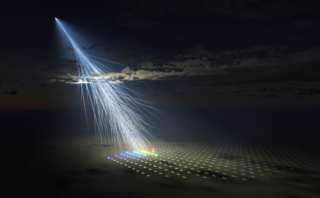Look Out for Cosmic Rays
Chris Lintott
Before the Large Hadron Collider was turned on fifteen years ago, it was suggested that the particle accelerator might bring about the end of the Universe. While believing this unlikely, CERN, which operates the collider, thought it best to check, and a panel of physicists was commissioned to find arguments to prove the collider was safe.
Their report, delivered just before the first protons smashed into one another, relied on the existence in the Universe of what are known as cosmic rays. These are highly energetic, rapidly moving particles. When they collide with something, the energy involved can be millions of times larger than anything physicists are capable of producing. The Earth itself exists despite being exposed to more than a million cosmic ray impacts at energies higher than anything at CERN, so we can be sure that bashing protons together in a tunnel underneath Geneva will not, in fact, imperil the Universe. (The technical version of the argument involves considering the collisions of cosmic rays with dense objects called neutron stars, though the principal idea is the same. Full details and the recently updated report are here.)
Spotting cosmic rays which collide with the Earth is a pastime growing popular with physicists. Rather than detecting incoming particles directly, we wait for a particle to hit an atom high in the Earth’s atmosphere, which will produce a cascade of secondary particles that reach the surface. A faint blue light may also appear, a phenomenon known as Cherenkov radiation, caused by particles in the cascade moving faster than light through the air. (Nothing can go faster than light in a vacuum, but in a medium, such as air or water, you can outpace it.)
For the last fifteen years, the Telescope Array – an assemblage of detectors spread across hundreds of kilometres of desert in Utah – has looked for these twin signals. Last week, in a paper analysing data from 27 May 2021, the team behind the search announced they had found the second most energetic particle ever detected. The press release mentions that the particle, nicknamed Amaterasu after the Japanese sun goddess, had the same kinetic energy as a golf ball travelling at 95 miles per hour. If it was a proton, that means it was moving at more than 0.999999999999999999999 times the speed of light. Basically, it was fast.
How it came to be travelling so fast is a puzzle. Normally, we blame cosmic rays on such dramatic events as supernovae, which mark the death of massive stars, but they don’t seem to be violent enough to have got Amaterasu up to speed. A better source may lie in the tangled magnetic fields which twist around the supermassive black holes that lurk in the centre of galaxies, though there’s no nearby galaxy in quite the part of the sky this particular cosmic ray seems to have come from.
Reflecting on the roughly 100 trillion neutrinos that pass through each of us every second, John Updike accused the particles of ‘Cosmic Gall’. Unlike neutrinos, particles such as Amaterasu can’t reach us directly because they are blocked by the atmosphere, but cosmic rays will be a problem for anyone undertaking a long voyage in space or hoping to live on the surface of a planet like Mars. Our biggest obstacle to exploring the solar system may turn out to be particles from events in galaxies millions of light years away.

Comments